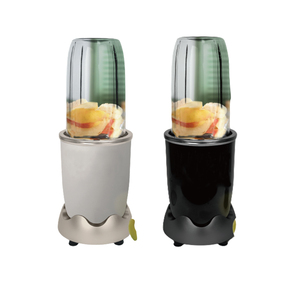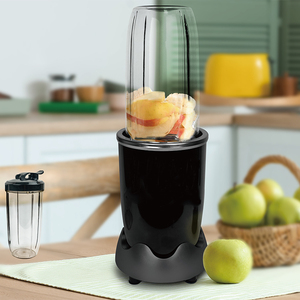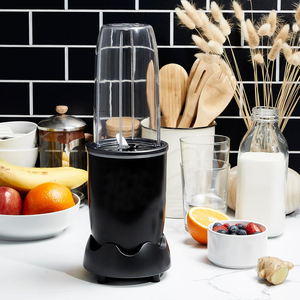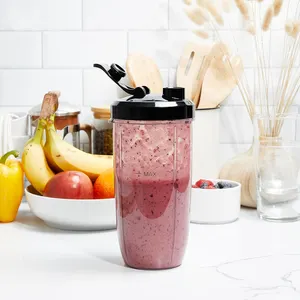
All categories
Featured selections
Trade Assurance
Buyer Central
Help Center
Get the app
Become a supplier

(7086 products available)















































An immersion blender is a versatile kitchen appliance that makes pureeing, blending, chopping, and mixing cooked food simple and practical. Generally, its parts include a blending head, a motor, and a guard. These parts work together to help the blender fulfill its role.
Blending Head
The blending head is an important part of the immersion blender. It has sharp, long, and stainless steel blades that chop through food and blend it into a smooth and consistent texture. Depending on the model, some blending heads may have only one or multiple blades. Also, the designs differ from one immersion blender to the other. Some blending heads have a tornado-like shape. This shape helps draw food down as it blends. Additionally, the blending head typically has a collar that locks onto the motor unit. This gives the blending head stability when attached and during operation.
Motor Unit
The motor unit is an important part of the immersion blender. This is where the magic happens. It has a powerful motor that rotates the blending blades at high speeds. This is what blends food into the desired texture. The motor unit also has a handle with buttons and speed settings. This makes it easy to hold and control the blender. Depending on the model, some motor units may have a maximum capacity of 800 to 1,000 ml.
Guard
The immersion blender guard is an important part of the immersion blender. It is the smooth and cylindrical part of the blender that protects the blades during blending. The guard usually surrounds the blending blades and may have different colors, depending on the brand or model. The guard's primary purpose is to allow safe operation. It ensures safe operation while reducing splash damage during use.
The purpose of an immersion blender is to create smooth purées and emulsions directly in the pot or bowl containing the ingredients. This versatile handheld kitchen appliance can replace traditional blenders, especially when working with hot soups or stews. Its ability to provide quick and easy blending has made it an essential tool in many home kitchens and professional culinary environments.
In recent years, immersion blenders have gained popularity as a convenient alternative to bulky countertop models. They take up less space in cabinets or on countertops when not in use because only the blending shaft needs to be stored away after each use instead of an entire pitcher or bowl like some cordless models do. This makes them ideal for small spaces where every bit matters - even time spent cleaning up after meals!
When choosing the right immersion blender, one must consider the features that could make food preparation easier. Its handheld design allows blending directly in pots, bowls, or glasses without transferring ingredients. Variable speed control lets users adjust speeds from gentle stirring to high-speed mixing for optimal results. Turbo boost provides an extra burst of power for tough blending tasks, while the whisper-quiet motor ensures noise-free operation. Furthermore, heat-resistant shafts can blend hot ingredients safely, and the cordless design offers maximum maneuverability.
Specific components of the immersion blender must be cleaned after use. Parts made of stainless steel and dishwasher-safe attachments provide durability and easy cleaning. Anti-suction design prevents the blender from getting stuck in the mixture, ensuring safe and effective operation. Finally, the assured quality indicates that the product is certified and tested for safety, giving customers confidence in its quality and performance.
Like the regular blender, the hand blender can be used for many different purposes. It is widely known that blenders are useful tools in the kitchen to make food prep easier. What many people may not realize is that hand blenders are used in industries outside the food sector.
Different parts of an immersion blender can help buyers differentiate between models and their functions. Buyers should know that not all blenders come with the same attachments and accessories; hence, they should seek parts that align with their specific requirements.
When it comes to selecting the right components for their needs, buyers should consider the type of food being blended or prepared. For instance, if buyers are blending soft fruits and smoothies, they can opt for blenders with whisks. Immersion blender whisks are designed to create light, fluffy mixtures and may not be ideal for thick mixtures such as pancakes or mashed potatoes.
The Material of the blender part is crucial, especially when it comes to the assembly process and cleaning. Buyers should get parts made with plastic, stainless steel, or other durable materials. Stainless steel immersion blenders are the safest options and are also more durable than their plastic counterparts. They are also heat resistant, which makes them ideal for hot soups. Although plastic blender parts are less expensive, they are usually not heat resistant. Additionally, plastic immersion blender parts tend to absorb odors and stains over time. However, when using plastic parts, it is important to note that they need to be handled with extra care because, at times, they can be prone to cracking or breaking.
Understand the Importance of blending speed and power. Customers should ensure they have a sufficiently powerful motor to meet their blending needs. Various blender parts determine blending speed and power, such as the measurements and shape of the blades. Longer blades might provide more power and a better reach, especially when blending large quantities of food in deep pots.
Choose immersion blender parts that are easy to clean and maintain. Immersion blenders with detachable parts are the easiest to clean because they can be sanitized by hand or placed directly in the dishwasher.
Q1: How can parts for immersion blenders be cleaned and maintained?
A1: Since a lot of blender parts are made of plastic, stainless steel, or glass, they are generally dishwasher safe. However, it's always best to check the manufacturer's instructions before putting anything in the dishwasher. For handwashing, use warm, soapy water and a sponge.
Q2: Is it possible to replace the cord on a corded immersion blender?
A2: It might be possible to replace the cord on a corded immersion blender, but it is generally not recommended. The most important thing is to make sure the new cord is compatible with the immersion blender. This will ensure the blender works properly and safely.
Q3: What is the average shelf life of immersion blender parts?
A3: The longevity of these parts varies greatly depending on usage, care, and quality. Typically, with proper care, the parts can last for many years. In a professional kitchen, immersion blender parts may wear out faster due to frequent use.
Q4: How to store immersion blender parts?
A4: Store them in a cool, dry place. Make sure to keep them together to avoid any mix-up or loss of parts. Using a container or drawer organizer can be helpful to keep everything organized.
Q5: Are there any safety precautions to take when using an immersion blender?
A5: Yes, it is important to hold the blender handle and not touch the blade while it is running. Also, do not use it in a hot pot without the handle, and keep kids far away.